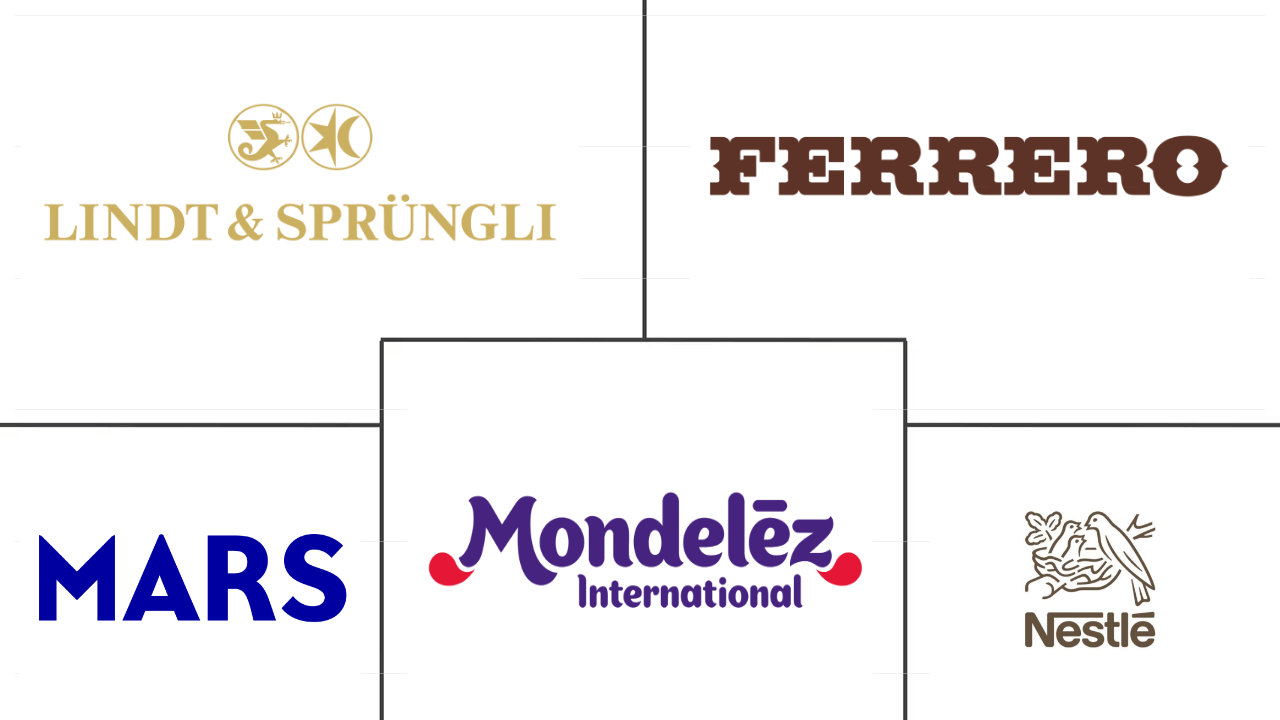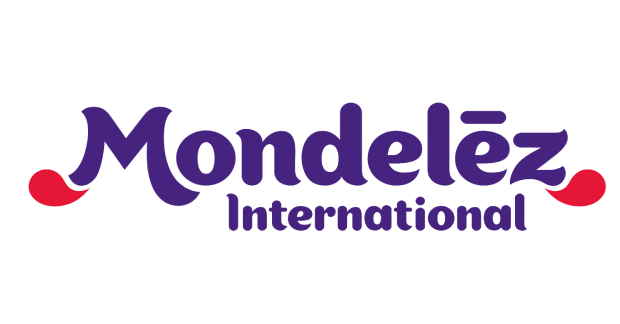Market Size of europe chocolate Industry
|
|
Study Period | 2018 - 2030 |
|
|
Market Size (2024) | USD 47.28 Billion |
|
|
Market Size (2030) | USD 61.42 Billion |
|
|
Largest Share by Distribution Channel | Supermarket/Hypermarket |
|
|
CAGR (2024 - 2030) | 4.46 % |
|
|
Largest Share by Country | United Kingdom |
Major Players |
||

|
||
|
*Disclaimer: Major Players sorted in no particular order |
Europe Chocolate Market Analysis
The Europe Chocolate Market size is estimated at 47.28 billion USD in 2024, and is expected to reach 61.42 billion USD by 2030, growing at a CAGR of 4.46% during the forecast period (2024-2030).
47.28 Billion
Market Size in 2024 (USD)
61.42 Billion
Market Size in 2030 (USD)
3.33 %
CAGR (2018-2023)
4.46 %
CAGR (2024-2030)
Largest Segment by Confectionery Variant
65.58 %
value share, Milk and White Chocolate, 2023
The innovative flavor offerings possible in white chocolate, along with varied taste profiles in the Europe region, led to segmental growth in the market studied.
Largest Segment by Distribution Channel
40.89 %
value share, Supermarket/Hypermarket, 2023
Consumers are increasingly preferring purchasing from supermarkets and hypermarkets due to wide offerings and expanding shelf space for innovative chocolate products.
Fastest-growing Segment by Confectionery variant
5.06 %
Projected CAGR, Dark Chocolate, 2024-2030
Rising awareness among consumers about dark chocolate's nutritional content, premiumization and stress-relieving ability is anticipated to drive the demand in the region.
Fastest-growing Segment by Distribution Channel
6.40 %
Projected CAGR, Online Retail Store, 2024-2030
The ease of shopping experience through online channels and the increasing number of retailers in this channel have become a major driver of the segment's growth.
Leading Market Player
19.74 %
market share, Mondelēz International Inc., 2022

An extensive range of product offerings and its main focus on taste and nutritional profiles based on consumer preferences support Mondelēz in the market studied.
Proximity factor of various distribution channels like supermarkets/hypermarkets and convenience stores drove the market, holding a share of almost 80% in 2023
- Supermarkets/hypermarkets are the largest channels in the European chocolate confectionery market. The channels grew by 3.62% by value in 2023 compared to 2022 in terms of the distribution channel segment for Europe’s chocolate confectionery sales. The proximity factor of these channels in the countries provides them with an added advantage of influencing the consumer’s decision to purchase among the large variety of products available in the market. The sales value of chocolate confectionery products in supermarkets and hypermarkets increased by 3.62% in 2023 compared to 2022 and is anticipated to register a CAGR of 4.01% during the forecast period in the region.
- Convenience stores are the second most widely preferred distribution channel after supermarkets and hypermarkets for purchasing chocolate products across Europe. The segment acquired a volume growth of 3.2% in 2023 compared to 2022. The key factors driving consumer preference for these stores are the broader reach and easy access to private-label brands and the increasing expansion of these channels. Among the regions, the United Kingdom recorded the highest number of convenience stores, with over 47,000 stores existing in the country in 2021.
- Online channels are the fastest-growing distribution channel through which chocolate confectionery products are consumed in the region. Consumers prefer online channels as they provide quick, convenient delivery options. The high internet penetration in the region also drives the demand for these channels. In 2022, the region had 750 million internet users, with an internet penetration rate of 89.7% of the total population. The online channels are further projected to register a growth of 18% by value from 2024 to 2027.
The United Kingdom, followed by Russia, leads the regional growth; together, they held a value growth of almost 45% in 2023
- The consumer’s paradigm shift toward high-quality chocolate products, such as single-origin chocolates, organic chocolates, handmade chocolates, artisan chocolates, and other chocolate products, is a major factor driving the regional chocolate market. There is tremendous demand for dark chocolates, as they have less sugar and taste more like cocoa, and they are perceived to be genuine and low in sugar content. By value, the European chocolate market observed a growth of 3.91% in 2022 compared to 2021.
- Germany and the United Kingdom are identified as the major markets in the region, followed by Russia and France. Germany and the United Kingdom collectively accounted for 46.24% of the chocolate sales in 2022. The increasing availability of different varieties of chocolates led to their high demand, fueled by the impulsive purchase behavior of consumers. Thus, with the growing demand for chocolate, country-level players are focusing on increasing their production. Germany produced about 1,182,000 tonnes of chocolates in 2020.
- Spain is identified as the fastest-growing chocolate market in Europe. The market is anticipated to grow at a rate of 5.64% from 2023 to 2024 in terms of value. Spain’s sweet tooth has been on the rise in recent years, with a peak in chocolate and cocoa product consumption. In 2022, the per capita consumption of chocolate in Spain was around 5.68 kg per person.
- By chocolate type, milk and white chocolate hold a significant share of more than 50% of Europe's chocolate market. The demand for white chocolate is expanding steadily. Leading milk and white chocolate brands, like Lindt, Cadbury, Galaxy, and Milky Bar, are widely popular among local consumers.
Europe Chocolate Industry Segmentation
Dark Chocolate, Milk and White Chocolate are covered as segments by Confectionery Variant. Convenience Store, Online Retail Store, Supermarket/Hypermarket, Others are covered as segments by Distribution Channel. Belgium, France, Germany, Italy, Netherlands, Russia, Spain, Switzerland, Turkey, United Kingdom are covered as segments by Country.
- Supermarkets/hypermarkets are the largest channels in the European chocolate confectionery market. The channels grew by 3.62% by value in 2023 compared to 2022 in terms of the distribution channel segment for Europe’s chocolate confectionery sales. The proximity factor of these channels in the countries provides them with an added advantage of influencing the consumer’s decision to purchase among the large variety of products available in the market. The sales value of chocolate confectionery products in supermarkets and hypermarkets increased by 3.62% in 2023 compared to 2022 and is anticipated to register a CAGR of 4.01% during the forecast period in the region.
- Convenience stores are the second most widely preferred distribution channel after supermarkets and hypermarkets for purchasing chocolate products across Europe. The segment acquired a volume growth of 3.2% in 2023 compared to 2022. The key factors driving consumer preference for these stores are the broader reach and easy access to private-label brands and the increasing expansion of these channels. Among the regions, the United Kingdom recorded the highest number of convenience stores, with over 47,000 stores existing in the country in 2021.
- Online channels are the fastest-growing distribution channel through which chocolate confectionery products are consumed in the region. Consumers prefer online channels as they provide quick, convenient delivery options. The high internet penetration in the region also drives the demand for these channels. In 2022, the region had 750 million internet users, with an internet penetration rate of 89.7% of the total population. The online channels are further projected to register a growth of 18% by value from 2024 to 2027.
| Confectionery Variant | |
| Dark Chocolate | |
| Milk and White Chocolate |
| Distribution Channel | |
| Convenience Store | |
| Online Retail Store | |
| Supermarket/Hypermarket | |
| Others |
| Country | |
| Belgium | |
| France | |
| Germany | |
| Italy | |
| Netherlands | |
| Russia | |
| Spain | |
| Switzerland | |
| Turkey | |
| United Kingdom | |
| Rest of Europe |
Europe Chocolate Market Size Summary
The European chocolate market is experiencing a steady expansion, driven by a shift in consumer preferences towards high-quality chocolate products such as single-origin, organic, and artisan chocolates. Supermarkets and hypermarkets dominate the distribution channels, benefiting from their proximity and extensive product offerings, while convenience stores also see significant consumer engagement due to their broad reach and accessibility. Online channels are emerging as the fastest-growing segment, fueled by high internet penetration and the demand for convenient delivery options. The market is characterized by a strong demand for dark chocolates, which are perceived as healthier due to their lower sugar content. Germany and the United Kingdom are key markets, with Spain showing the fastest growth rate in recent years.
The market is moderately consolidated, with major players like Lindt, Ferrero, Mars, Mondelēz, and Nestlé holding significant shares. The consumption patterns in Europe reflect a mix of health perspectives, with a notable preference for milk and dark chocolates. Price fluctuations in the industry are influenced by changes in raw material costs, impacting consumer purchasing behavior, especially during economic downturns. The market's growth is also supported by innovations such as plant-based chocolates and vegan options, catering to evolving consumer tastes and dietary preferences.
Europe Chocolate Market Size - Table of Contents
-
1. MARKET SEGMENTATION (includes market size in Value in USD and Volume, Forecasts up to 2030 and analysis of growth prospects)
-
1.1 Confectionery Variant
-
1.1.1 Dark Chocolate
-
1.1.2 Milk and White Chocolate
-
-
1.2 Distribution Channel
-
1.2.1 Convenience Store
-
1.2.2 Online Retail Store
-
1.2.3 Supermarket/Hypermarket
-
1.2.4 Others
-
-
1.3 Country
-
1.3.1 Belgium
-
1.3.2 France
-
1.3.3 Germany
-
1.3.4 Italy
-
1.3.5 Netherlands
-
1.3.6 Russia
-
1.3.7 Spain
-
1.3.8 Switzerland
-
1.3.9 Turkey
-
1.3.10 United Kingdom
-
1.3.11 Rest of Europe
-
-
Europe Chocolate Market Size FAQs
How big is the Europe Chocolate Market?
The Europe Chocolate Market size is expected to reach USD 47.28 billion in 2024 and grow at a CAGR of 4.46% to reach USD 61.42 billion by 2030.
What is the current Europe Chocolate Market size?
In 2024, the Europe Chocolate Market size is expected to reach USD 47.28 billion.

